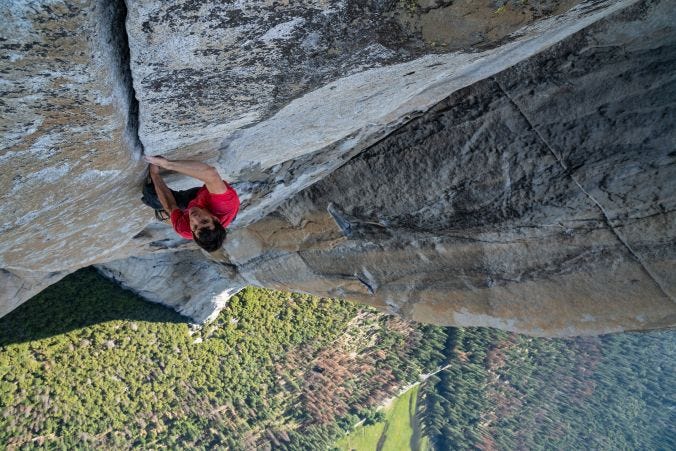Anxiety, Brains, Fear, Alex Honnold


WAIT–WHY ARE WE LOWER THAN THE TOP!?!?!? See: https://www.tested.com/science/life/454072-why-bigger-neanderthal-brains-didnt-make-them-smarter-humans/
A long time ago, our species evolved bigger brains. Luckily, these larger brains allowed us to communicate with one another more effectively, help us hunt bigger animals in teams, and share stories and experiences with one another. We started being pretty successful as Homo sapiens, and shared stories or mental frameworks allowed us to develop increasingly complex communities. We’ve gone on to create civilizations, nation-states, religions, and all kinds of amazing projects — cities like New York, Tokyo, and Berlin. Rocketships have taken us to the moon and back. Transportation, communication, and information networks connect the entire world. Older, as well as modern systems, provide water, electricity, and food to 7 billion humans all over the globe. Economic systems and forms of money help distribute and facilitate the acquisition, transfer, and storage of the world’s resources, goods, and services. Agriculture, sports, art, music, books, war…Honey Chipotle Chicken Crispers from Chili’s. We made it all. All with the help of these amazing brains of ours.

Recall, though, that our species was essentially plucked out from the middle of the food chain and put at the top. Or more specifically, that our brains were built to help us survive all the evolutionary pressures of the savannah. So these incredible brains of ours are still constantly on the lookout for danger (real or perceived). This can also be summed up by a simple tweet that makes me smile to this day:

This amazing organ that brought us to incredible heights also comes with problematic remnants from its past. In the modern world, these same fight or flight responses abound as perceived threats loom around every corner. Reading the news makes our cortisol levels rise and generally tells us everything is just about to fall apart. Fear/anxiety: used to be super useful as a survival mechanism. Now: usually not so much.
I decided to write today about this anxiety, a problem that these brains of ours experience frequently, and some strategies to combat it.
To help address this topic I want to share the story about a particularly awesome Homo sapien, Alex Honnold, who loves climbing. Thanks to a combination of nature and nurture, his brain is pretty special. See this area of the brain that fires on most people? The amygdala? Current scientific understanding tells us that this area of the brain is responsible for handling the limbic system and many of the resulting anxious responses in our bodies.

This brain area for Alex is essentially dead. He really doesn’t seem to “feel” or process emotions like fear like so many of us do: The Strange Brain of the Worlds Greatest Solo Climber
While his brain is a unique result of nature and nurture, I think we can learn a lot from Alex from the way he has nurtured this skill and how he approached his most recent triumph, what many consider to be one of the greatest athletic feats in modern human history, climbing El Capitan without a rope. It’s truly a mind-blowing feat for any of us to fathom. Luckily for us, there was a world-class film crew on hand to capture the experience: https://www.nationalgeographic.com/films/free-solo/

I can’t wait to see the film.
Even just looking at the videos or clips of this feat is enough to produce physical responses in the viewer. The co-filmmaker himself admitted that “[n]ot a day went by that [he] didn’t think about the worst.” [of Honnold plummeting to his death.] How did Honnold conquer this? Continue reading for some ideas.
While many of us will never reach Honnold’s level of “no response” that his brain and body exhibit through massive amounts of practice, there are some basic strategies we can use to improve ourselves in this area of life. Another group of sapiens I admire a lot for their ability to consistently and systematically overcome fear and stress is the U.S. Navy SEALs.

SEAL training teaches new recruits about four main tools they can use to combat the amygdala and all the resulting bodily responses:
1) Goal setting
People hear this a lot. I almost groan now because I have heard it from so many teachers and leaders over the years. But goal setting activates the higher part of our brain, the pre-frontal cortex, which helps keep the lower, survival-based amygdala in check.
Honnold had the goal of climbing El Capitan since about 2009 when he completed his free-solo of Half Dome. And he has devoted his life to climbing, and much of that time to the art of free-soloing. The planning and time that went into the feat is astounding.
Note that Honnold was also looking beyond his big goal, not letting it overwhelm him:
Asked after the historic event: “So you already have a new goal?”
It’s been a strategy the whole time I’ve worked on El Cap is to look past it, so that it’s not just all this one moment. To think about what’s beyond, what other stuff I’m excited about. So this just feels like a semi-normal day.
Otherwise you’re kind of setting yourself up for a major letdown?
You don’t want to put that much pressure on yourself where everything in my life focuses on this one moment. This has been my big focus for years and my big dream for years, but I would like to climb at my physical limits and step away from adventure for a little while.
2) Visualization
The brain is really bad at distinguishing imagined events and experiences from those that really happen. When you dig into the science deeper, you come to realize that everything stored biologically/physically in the massive networks of synapses we have is just a representation that the brain retrieves when required. There are many ways of creating these representations.
In the sporting arena, visualization has long been employed by top performers. Michael Phelps had the ideal physical body and coupled it with a fanatic training regimen. But he also began utilizing visualization as a 13-year old. His Coach, Bowman, would tell him to rehearse the perfect race in his head before he went to sleep. And at certain times in training would push Michael, telling him to “put the tape in.”
There is a distinct calmness that comes from experience. You can gain huge amounts of calm (and therefore better attend to the task at hand) through visualization.
Honnold both visualized and actually practiced his routes thousands upon thousands of times until the brain knew what to expect on a deeper, unthinking level. It became routine.
3) Self-talk
What we say to ourselves over and over again is incredibly powerful for our brains. While the science is still in flux on the matter, it can be helpful to know that the discussion on number of thoughts per day for a human usually falls in between 12,000 and 600,000+ “thoughts” (subconscious or conscious). If you can even tip some of your habitual thought patterns more in your favor it can be a massive help.
Others might just call this self-confidence. What do you constantly say to yourself? Is it empowering? Positive? Would your thoughts change if there was a Jumbotron above your head displaying your thoughts constantly to those around you?
Both consciously in the moment, and subconsciously built up over time, what we say to ourselves (about ourselves) has a lasting effect.
Honnold when asked by Tim Ferriss about self-talk:
When you are getting ready for a challenging climb, what does your self-talk sound like? Do you have any anything you ritualistically say to yourself before you get going?
No, I don’t really. I don’t self-talk like that. But normally if I’m planning on doing something challenging, I spend the time visualizing what the experience will feel like. With climbing, there’s a component of memorizing the actual moves. So I’ll think through the sequences and make sure that I remember which foot to move in which order and like how to do everything. And then if I’m climbing ropeless, then I’ll think through what it’ll feel like to be in certain positions. Because some kinds of movements are just scarier. It’s important to think through how that will all feel when I’m up there, so that when I’m doing it I won’t suddenly be like, Oh my God, this is really scary. I know that it’s supposed to be scary, I know what it’s going to feel like, and I just do it.

4) Regulation
AKA long deep breaths.
Simple breathing practices, awareness of breath meditation, yoga, etc. can all be helpful here, to help calm the body and mind as one. To tell your own brain, it’s okay, it’s safe, we’re breathing easily, there is no survival stress here.
Some closing thoughts from Alex on what life lessons he takes from climbing:
From the actual climbing itself, the most useful thing I’ve learned is how to differentiate risk and consequence and fear, and how to separate my feelings from what’s actually happening. When you’re really hungry you’re not like, Oh God, I’m hungry, I’m hungry! You’re just like, Oh, I’ll eat lunch in two hours. Fear to some extent should be the same way. You can register, Oh, I’m feeling fear right now, but know that sometimes that doesn’t matter. Sometimes it does, and you need to watch out for that. But a lot of times, you should be able to set that fear aside and do exactly what you’re supposed to be doing.
So there you go, some thoughts and four useful tools to help you work with your beautiful, amazing, unique, powerful mind when that is required.
If you liked this post or found it at all helpful, please share it and/or comment to let me know your thoughts.
Further reading and all links:
https://www.nationalgeographic.com/films/free-solo/
http://nautil.us/issue/39/sport/the-strange-brain-of-the-worlds-greatest-solo-climber
Advertisements



